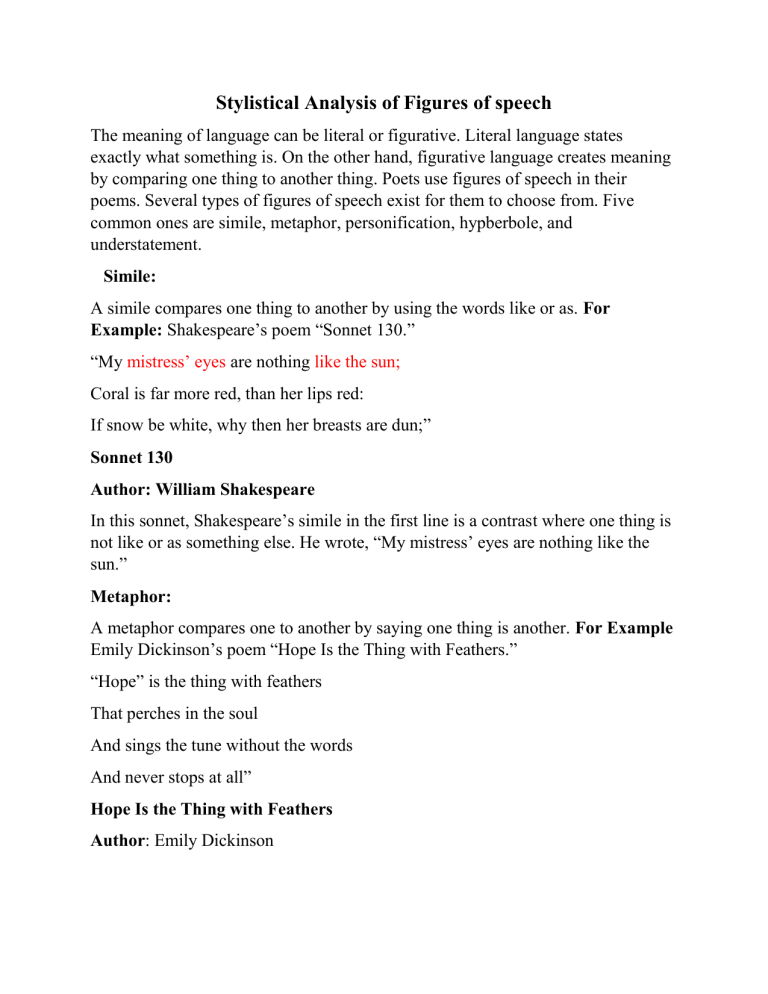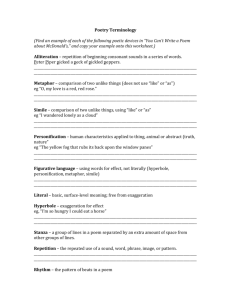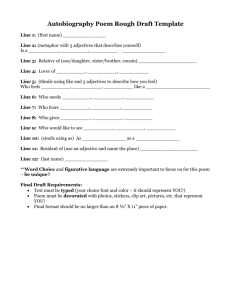
Stylistical Analysis of Figures of speech The meaning of language can be literal or figurative. Literal language states exactly what something is. On the other hand, figurative language creates meaning by comparing one thing to another thing. Poets use figures of speech in their poems. Several types of figures of speech exist for them to choose from. Five common ones are simile, metaphor, personification, hypberbole, and understatement. Simile: A simile compares one thing to another by using the words like or as. For Example: Shakespeare’s poem “Sonnet 130.” “My mistress’ eyes are nothing like the sun; Coral is far more red, than her lips red: If snow be white, why then her breasts are dun;” Sonnet 130 Author: William Shakespeare In this sonnet, Shakespeare’s simile in the first line is a contrast where one thing is not like or as something else. He wrote, “My mistress’ eyes are nothing like the sun.” Metaphor: A metaphor compares one to another by saying one thing is another. For Example Emily Dickinson’s poem “Hope Is the Thing with Feathers.” “Hope” is the thing with feathers That perches in the soul And sings the tune without the words And never stops at all” Hope Is the Thing with Feathers Author: Emily Dickinson Notice that Emily Dickinson compared hope to a bird–the thing with feathers. Because there are bird images throughout the poem, it is called an extended metaphor poem. Personification: A personification involves giving a non-human, inanimate object the qualities of a person. Robert Frost did that in his poem “Storm Fear.” “When the wind works against us in the dark, And pelts with snow The lower chamber window on the east, And whispers with a sort of stifled bark, The beast, ‘Come out! Come out!—" Storm Fear Author: Robert Frost Look specifically at the strong action verbs to find the human traits that are attributed to the wind and storm. Hyperbole: A hyperbole is an exaggeration of the truth in order to create an effect. Sometimes that’s done in a single statement. Other times it can happen with repetition like in Robert Frost’s famous poem “Stopping by Woods on a Snowy Evening.” Notice the effect of the last two lines. The reader feels the tiredness of the weary traveler. “The woods are lovely, dark and deep, But I have promises to keep, And miles to go before I sleep, And miles to go before I sleep.” Stopping by Woods on a Snowy Evening Author: Robert Frost Understatement Understatement is the exact opposite of a hyperbole. The writer deliberately chooses to downplay the significance or seriousness of a situation or an event. This is evident in Mary Howitt’s Poem ” The Spider and the Fly.” “Will you walk into my parlour, said a Spider to a Fly; ‘Tis the prettiest little parlour that ever you did spy. The way into my parlour is up a winding stair, And I have many pretty things to shew when you get there. Oh, no, no! said the little Fly; to ask me is in vain: For who goes up that winding stair shall ne’er come down again.” The Spider and the Fly Author: Mary Howitt


